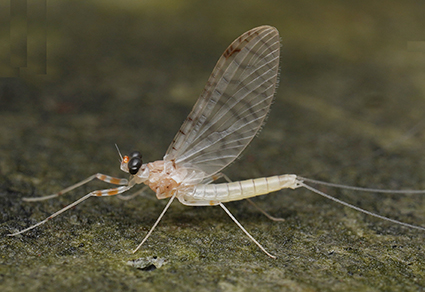Abstract
The nymphs of the leptophlebiid mayfly Gilliesia pulchra Zhou, 2004 have not been reported before, which inhibits deeper understanding of the taxonomy and phylogenetic position of this species and its genus. In 2022, we reared nymphs from southwestern China to the adult stage. All stages are described and photographed here. Nymphs of this species have single deeply-forked gills, somewhat elongated maxillary palpi and two setal tufts on the lingua. Its imaginal characteristics, including wings and penes, are quite similar to G. hindustanica (Gillies, 1951), the type species of the genus. Comparatively, the third species of the genus, G. ratchaburiensis Boonsoong & Sartori, 2015, seems less similar, both in adults and nymphs. Generally, features of G. pulchra nymphs link the two genera Gilliesia Peters & Edmunds, 1970 and Habrophlebiodes Ulmer, 1919 together, while features of the nymphs of G. ratchaburiensis bridge the genera Gilliesia and Dipterophlebiodes Demoulin, 1954.
References
- Boonsoong, B. & Sartori, M. (2015) The nymph of Gilliesia Peters & Edmunds, 1970 (Ephemeroptera: Leptophlebiidae), with description of a new species from Thailand. Zootaxa, 3981 (2), 253–263. https://doi.org/10.11646/zootaxa.3981.2.6
- Demoulin G. (1954) Les Ephéméroptères Leptophlebiidae de Borneo. Bulletin et Annales de la Société Entomologique de Belgique, 90(5–6), 129–131.
- Gillies, M.T. (1951) Further notes on Ephemeroptera from India and South East Asia. Proceedings of the Royal Society of London (B), 20, 121–130. https://doi.org/10.1111/j.1365-3113.1951.tb01009.x
- Kluge, N.J. (1994) Habrophlebiinae subfam. n. with description of a new species of Habroleptoides from Caucasus (Ephemeroptera: Leptophlebiidae). Zoosystematica Rossica, 3, 35–43.
- Li, D., Wang, Y.X. & Zhou, C.F. (2013) Commentary on the Asian species of Habrophlebiodes and redescription of the nymph of H. zijinensis (Ephemeroptera: Leptophlebiidae). Entomotaxonomia, 35 (1), 11–18. [in Chinese]
- Peters, W.L. (1972) The nymph of Dipterophlebiodes sp. (Leptophlebiidae: Ephemeroptera). Entomological News, 83, 53–56.
- Peters, W.L. & Edmunds, G.F. Jr. (1970) Revision of the generic classification of the Eastern Hemisphere Leptophlebiidae (Ephemeroptera). Pacific Insects, 12, 157–240.
- Ulmer G. (1919) Neue Ephemeropteren. Archiv für Naturgeschichte, 85 (11), 39–40.
- Zhou, C.F. (2004) A new species of genus Gilliesia Peters & Edmunds from China (Ephemeroptera: Leptophlebiidae). Zootaxa, 421, 1–4. https://doi.org/10.11646/zootaxa.421.1.1


